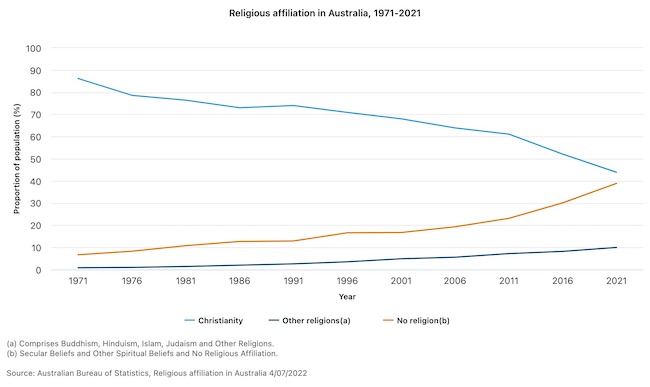The results of the 2021 Census have confirmed that Australia is experiencing a major shift in its religious, demographic and cultural character.
For the first time in Australia’s history, those identifying themselves as Christians are now a minority with just 44 per cent practicing Christianity, a decline of over 15 percent in five years. In 1971, 86 per cent Australians identified as Christians.
While fewer people are reporting their religion as Christian, more are reporting ‘no religion’. Almost 40 per cent (38.9 per cent) of Australia’s population reported having no religion in the 2021 Census, an increase from 30 per cent (30.1 per cent) in 2016 and 22 per cent (22.3 per cent) in 2011.
Other religions are growing but continue to make up a small proportion of the population. Hinduism has grown by 55.3 per cent to 684,002 people, or 2.7 per cent of the population. Islam has grown to 813,392 people, which is 3.2 per cent of the Australian population. Sikhism has grown to 210,400, an increase of 66.67 per cent since 2016.

Change in religious affiliation over time
Over the past 50 years, there has been a steady decline in the proportion of Australians who reported an affiliation with Christianity. The same period has seen a consistent rise in Other religions and No religion, particularly in the last 20 years.
The trend of an increase in Other religions and No religion in Australia is reflected in the religious affiliation of migrants who arrived since the last Census.

Growth in affiliation with Other religions
In 2021, over 2.5 million people reported an affiliation with Other religions. This was an increase of over 600 thousand (617,800) since 2016.
In the past 25 years the proportion of people reporting an affiliation with Other religions has increased from 3.5% in 1996 to 10% of the population in 2021. This growth has particularly accelerated since 2006.

These increases reflect Australia’s migration trends. In 2021, 93.8% of people affiliated with Other religions were either born overseas or had at least one parent born overseas.
In 2021, the main religions in Other Religion in Australia were Islam, Hinduism, and Buddhism.
In the 1981 Census, data on Buddhism was released for the first time in response to the arrival of large numbers of Buddhists as Vietnamese refugees in the 1970s. A steady increase since then has largely been maintained by migration from Southeast Asia, China and Sri Lanka.
While the numbers of Buddhists continue to increase, in 2021 the main contributors to the increase in Other religions were:
- Hinduism (243,700)
- Islam (209,150)
- Sikhism (84,500)
These increases were largely a result of recent migration from Southern and Central Asia.
Of migrants who arrived in Australia between 2016 and 2021, there were 210,500 who were affiliated with Hinduism. Most of these migrants (91.9%) were born in India and Nepal.
Similarly, nearly 60 thousand (57,300) recent migrants were affiliated with Sikhism, and almost all (95.9%) were born in India. Sikhism has grown in Australia particularly over the past ten years. The number of people who affiliate with Sikhism has almost tripled since the 2011 Census. In 2021, they accounted for 0.8% of the population (210,400 people).
The increase of Islamic affiliation can also be largely attributed to recent migration. Almost 126,000 people who arrived in Australia between 2016 and 2021 affiliated with Islam. Their main countries of birth were Pakistan, Afghanistan, India and Bangladesh.











